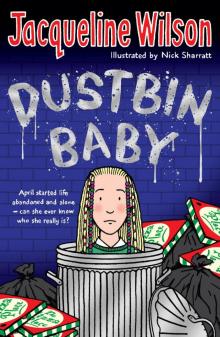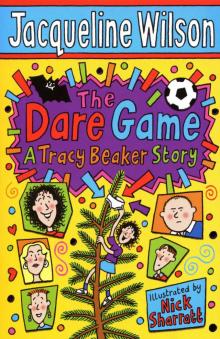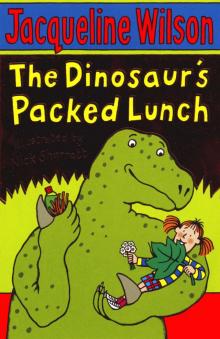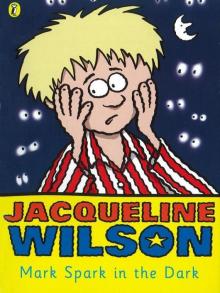- Home
- Jacqueline Wilson
Jacky Daydream Page 4
Jacky Daydream Read online
Page 4
They nearly always mention their pets before their parents and brothers and sisters, as if they’re much more important. The sad thing is, pets don’t live as long as people. I often get the most touching tear-stained letters, telling me that some beloved hamster or white rat has died.
I decided to write a story about a girl whose old cat dies. She feels terrible and wishes she could preserve her in some way. She’s just learned about the Ancient Egyptians at school and it gives her a very very weird idea!
8
Shopping
I LOVED LIVING as an extended family at Fassett Road. I liked all the little routines of my preschool life. We would walk into Kingston every day to go shopping. It was a fifteen-minute brisk trot, a twenty-five-minute stroll. Biddy stuck me in my pushchair to save time. It was a pleasant walk, across a little blue bridge over the Hog’s Mill stream, down a long quiet street of Victorian houses, some large, some small, past the big green Fairfield, past the library, until we could see the red brick of the Empire Theatre in the middle of town. (I was taken to see Babes in the Wood there when I was little and loved it, though I found it puzzling that the boy Babe was a girl and the Old Dame clearly a man.)
Ga had already developed arthritis and could only walk slowly, so we strolled together, peering at everything along the way. We had our favourite houses. She would always pause in front of a pretty double-fronted house with four blossom trees in the garden. ‘That’s my favourite,’ she’d say, so of course it was my favourite too.
I live in that house now. My grandma is long dead, but I’ve hung her photo on the wall – and a replacement china Mabel sits underneath.
Shopping was very different in those days. I loved going to Sainsbury’s, but it wasn’t a big supermarket with aisles and open shelves and trolleys. The Kingston Sainsbury’s then had beautiful mosaic-tiled walls like an oriental boudoir. You queued at the butter counter and watched some white-overalled wizard take the butter and pat it into place with big wooden paddles. You couldn’t afford very much butter so you always had margarine too. They were both so hard you had to butter the end of the loaf and then slice it. There wasn’t any such thing as ready-sliced bread in packets then.
Then you queued at the cheese counter until another white-garbed lady sliced off the exact amount of cheese for you with a wire and ticked your ration book. You queued at the bacon counter and watched the bacon boy (who always wore a pencil behind his ear) use the scary bacon slicer, cutting your four rashers of best back bacon into wavy ribbons on greaseproof paper. You could queue for a whole hour in Sainsbury’s and still come out with precious little in your string shopping bag.
Then we’d go to John Quality’s on the corner by the market. It was another grocer’s, with big sacks of sugar and nuts and dried fruit spread out on the floor, just the right height for me. I was always a very good girl, but Gwennie sometimes darted her hand into a sack and pulled out a dried plum, just like Little Jack Horner in the nursery-rhyme book at home.
Then we’d trail round the market, maybe queuing for plaice or cod or yellow smoked haddock from the fish stall on a Friday, spending a long time haggling at the fruit stall and the veg stall. You could get bananas and oranges now the war was over, but everything was strictly seasonal and none of us had ever even heard of exotic things like kiwi fruit or avocado pears or butternut squash. Fruit meant apples and pears, veg meant cabbage and carrots and cauliflower. The frozen pea hadn’t even been invented. We didn’t have a fridge or freezer anyway.
The only shop I disliked was the butcher’s – it smelled of blood. The meat wasn’t cut up in neat cellophaned packets, it was festooned all over the place, great red animal corpses hung on hooks in the wall, chickens still in their feathers, rabbits strung in pairs like stiff fur stoles, their little eyes desperately sad.
I shut my own eyes. I breathed shallowly, trying hard not to moan and make a fuss, because if I’d behaved perfectly, I might be taken to Woolworths for a treat. I loved Woolworths. It had its own distinctive smell of sweets and biscuits and scent and floor polish. (When I left home and went to live in Scotland at seventeen, I used to go into the Dundee Woolworths just to breathe in that familiar smell.)
I liked the toy counter best. I’d circle it on tiptoe, trying to see all the penny delights: the glass marbles, the shiny red and blue and green notebooks, the spinning tops, the tin whistles, the skipping ropes with striped handles. I always knew what I wanted most. Woolworths sold tiny dolls, though sadly not the beautiful little china dolls of my grandma’s childhood. These were moulded pink plastic – little girls with pink plastic hair and pink plastic dresses, little boys with pink plastic shirts and pink plastic trousers, and lots and lots of pink plastic babies in pink plastic pants. The babies came in different sizes. You could get big penny babies alarmingly larger than their halfpenny brothers and sisters.
I was a deeply sexist small girl. I spurned all the pink plastic boys. I bought the girls and the little babies, playing with them for hours when I got home. I sometimes made them a makeshift home of their own in a shoebox. I took them for trips to the seaside in my sandpit. Best of all, I stood on a stool at the kitchen sink and set them swimming in the washing-up basin. They dived off the taps and went boating in a plastic cup and floated with their little plastic toes in the air.
I was very fond of the water myself. I hadn’t yet been swimming in a proper pool but we’d had several day trips to Broadstairs and Bognor and Brighton when I’d had a little paddle. Most days in the summer Ga took me for a ten-minute walk to Claremont Gardens, near Surbiton Station, where there was a paddling pool. She stripped me down to my knickers and I ran into the pool and waded happily in and out and round about.
I wasn’t supposed to go right under and get my knickers wet, but even if I was careful, the other children often splashed and I got soaked. One time Ga thought my knickers were so sopping wet I’d be better off without them, so she pulled my dress on, whipped my knickers off, and walked home with them clutched in a soggy parcel in her hand. We encountered Mrs Wilton, her next-door neighbour, on the way home.
‘Look at this saucepot!’ said Ga, twitching up my dress to show my bare bottom.
Then she waved my wet knickers in the air while she and Mrs Wilton laughed their heads off. I was mortified. I was worried Mrs Wilton might think I’d wet my knickers and then she’d tell her children, Lesley and Martin, and they’d think me a terrible baby.
I liked the trips to the paddling pool, but the best treat of all was a walk to Peggy Brown’s cake shop in Surbiton. There’s a health food shop on the site now, but in the long-ago days of my childhood the only health supplements we had were my free orange juice for vitamin C (delicious) and cod liver oil for vitamins A and D (disgusting) and some black malty treacle in a jar that my grandpa licked off a spoon every day.
Our concept of eating for health was a little skewed too: a fried-egg-and-bacon breakfast was considered the only decent way to start the day so long as you were lucky enough to have the right number of coupons; white bread and dripping was a nutritious savoury snack; coffee was made with boiled full-cream milk and a dash of Camp; and as long as you ate your bread and butter first then you always tucked into a cake at tea time.
Ga made proper cooked meals every day. She rolled her own pastry and made wonderful jam with the berries from the back garden, but I can’t remember her baking cakes. On ordinary days we had pink and yellow Battenburg cake or sugary bath buns from the baker’s near Kingston market – but once a week we went to Peggy Brown’s special cake shop.
They were fancy cakes with marzipan and butter cream and little slithers of glacé cherry or green angelica. They had exotic names: Jap cakes, coconut kisses, butterfly wings. There were tarts with three different jams – raspberry, apricot and greengage, like traffic lights. My favourites were little individual lemon tarts with a twirl of meringue on top.
Excellent as they were, the cakes were only incidental. We went to Peggy Brown’s to look
at the shop windows. The owner had a vast collection of dolls, from large Victorian china dolls as big as a real child down to tiny plastic dolls not very different from my Woolworths girls.
Each season Peggy Brown did a magnificent display: false snow and a tiny Christmas tree in winter; Easter eggs and fluffy bunnies in the spring; real sand and a painted blue sea in summer; red and gold leaves and little squirrels in autumn. Each season every single doll had a new outfit. They had hoods and mufflers and velvet coats, Easter bonnets and party frocks, swimming costumes and tiny buckets and spades, Fair Isle jumpers with matching berets and miniature wellington boots.
Ga and I gazed and gazed. Ga worked out how Peggy Brown had designed the costume, cut the pattern, sewn the seams. I rose up, strode straight through the glass and squatted amongst the dolls. We made a snowman or stroked the rabbits or paddled in the sea or kicked the crackly autumn leaves until Ga gave me a little tug. I’d back out of the glass into the real world and we’d go home and eat our Peggy Brown cakes for tea.
* * *
Which of my books features an entire collection of treasured dolls?
* * *
It’s Lizzie Zipmouth.
Dolls! Old china dolls in cream frocks and pinafores and little button boots, soft plush dolls with rosy cheeks and curls, baby dolls in long white christening robes, lady dolls with tiny umbrellas and high heels, a Japanese doll in a kimono with a weeny fan, dolls in school uniform and swimming costumes and party frocks, great dolls as big as me sitting in real wicker chairs, middle-sized dolls in row after row on shelves, and tiny dolls no bigger than my thumb standing in their own green painted garden beside a doll’s house.
I once had a very touching letter from a little girl of about nine. She loved playing with Barbies but a friend had come to tea and thought her a terrible baby because she still played with dolls. She told everyone at school and now my poor girl was getting horribly teased. I wrote back to tell her that I’d played with dolls right throughout my childhood and that I still had several sitting on my windowsills or lolling on spare sofas.
I put lots of dolls in my books, especially in Lizzie Zipmouth, where Lizzie and her scary step-great-gran bond over their love of dolls. It’s a bonding thing in my family too. Ga loved dolls, Biddy loved dolls – in fact she’s got a collection that outnumbers Great-Gran’s. Hundreds of little glass eyes stare at you when you go into her spare room! I’ve got all kinds of dolls in my house too, and so has my daughter Emma.
9
Lewisham
WE MOVED WHEN I was nearly four. Jean, one of Biddy’s friends, had a brother who rented a small flat in a three-storey house in Lewisham. He was ready to move on now, so Biddy and Harry took his two rooms.
I’m sure they were glad to get their own place. I wasn’t as keen. I missed Ga and our daily routines and my treats terribly. It wasn’t as if I had a place of my own. I still had to share their bedroom. I had my small bed and a rug where I was allowed to line up my dolls, and that was it.
We learned pretty quickly why Jean’s brother was so keen to move on. A demented man called Stanley lived on the ground floor. He screamed abuse at his cowed wife. He screamed abuse at us too, and at poor Miss Parker, the retired lady who lived on the top floor. He crouched in his flat, ears cocked, and the moment he heard you coming down the garden path he’d be at his window, purple in the face, screeching.
‘Hurry up the steps because of Stanley,’ my mum would say when we came back from shopping trips. She didn’t need to tell me twice. I charged up in my Clarks sandals, tripping in my haste.
We couldn’t escape him even when we were upstairs in our flat. Stanley would start slamming his own door violently. Not once or twice. Over and over again for a good fifteen minutes, while the whole house shook. Harry was out at work at the Treasury from Monday to Friday. Biddy and I were stuck at home. We went out as much as possible, taking the tram as far as we could afford.
I looked young for my age so Biddy sat me on her lap and pretended I was under three so she didn’t have to pay the fare. She let me take a book with me if it was a long journey. I now owned the Margaret Tarrant storybook as well as the nursery rhymes. Margaret Tarrant was very popular in those days and Ga sent me Margaret Tarrant animal postcards every week. I also had Pookie, a story about a white rabbit with wings, but all these books were too big and cumbersome to take out. I took a Shelf Animal book instead. They were the same size and format as Beatrix Potter, twee tales about toy animals – Stripy the Zebra, Getup the Giraffe, Woeful the Monkey, Gumpa the Bear and a small, fluffy, teddy-type creature called Little Mut.
I begged Biddy and Harry to read them to me at bed time. Now on the tram I murmured my own versions of the stories as I flipped the pages, looking at the brightly coloured pictures. It looked for all the world as if I was reading. Passengers gazed at me in awe and complimented my mother on my precocity. Biddy smirked, pleased she could take pride in me at last. I usually made her cringe in public. I was still immaculately turned out but I had developed a ferociously needy thumb-sucking habit. I didn’t just suck my thumb, I frequently hid my nose in a pocket handkerchief, rubbing the soft cotton with my finger.
‘Take that thumb out of your mouth and put that hankie in your pocket! You look tuppence short of a shilling,’ Biddy said, again and again.
Sometimes she’d jerk my thumb out impatiently but I stubbornly stuck it straight back. I was missing Ga. Maybe Biddy was too. We were certainly both missing Kingston.
We went up onto Blackheath once, but it seemed too bare and wide and empty compared with the oak woods and red deer of Richmond Park, or the gentle meadows of Home Park, with its flocks of sheep and speckled fallow deer. We went to the Lewisham shops but they weren’t a patch on Kingston. There wasn’t even one market, whereas we had three in Kingston: a big fruit and vegetable market, a little apple and flower market, and on Mondays a huge bustling free-for-all market with ducks and chickens and rabbits, bolts of material, socks and knickers, kiddies’ clothes, glittery jewellery, toys, kitchenware and general junk.
Lewisham’s big shops didn’t compare either. They didn’t have a Hides, with wonderful wooden cabinets with labelled drawers, and a money machine that whizzed over your head on a track all round the ceiling like a little runaway train, and then chugged back again with your change. It didn’t have Bentalls department store, with its fancy Tudor Rose restaurant where Ga and Gongon took me once for a special treat. Bentalls had a big book department, and toys, and Royal Doulton china ladies, and every season they had a special fashion show, with real mannequins swishing up and down the catwalk. The compère told you their names – Jean and Pam and Suzie and Kay – so you felt as if they were your friends. There was always one older, slightly stouter model, and she got called Mrs Harris. I played in my head that she looked after all the other girls and cooked them their supper at night.
We arrived very late for one fashion show and were stuck right at the back, where I couldn’t see a thing. Biddy urged me to burrow forwards, though I felt too shy to barge too far. Then suddenly I was lifted up onto a lovely older girl’s lap, where I sat entranced for the rest of the show. She was very fair and very thin, with a silver bangle that slid up and down her delicate arm. She let me try it on and everyone went ‘Aaah!’ I sensed from the way everyone was staring that she was special.
Biddy was pink with excitement when I was returned to her.
‘Do you know who that was? Petula Clark!’
She was a very famous child actress and singer. We listened to her in Meet the Huggetts on the radio. She went on to be an internationally acclaimed singer in her adult life. Every time I heard her sing ‘Downtown’ I’d bore my friends, saying, ‘Guess what! I’ve sat on Petula Clark’s lap!’
* * *
Which family in one of my books lives in a rented flat above a difficult complaining old lady called Mrs Luft?
* * *
It’s Marigold and Star and Dolphin in The Illustrated Mum.
‘What a racket!’ Mrs Luft was down at the front door sorting through the post. She seemed to be addressing an invisible audience. ‘Do they have to be so noisy on the stairs? Up and down, late at night, first thing in the morning. Some people have no consideration.’
Mrs Luft is a positive saint compared with Stanley! I’m sure she feels Marigold and her girls are the worst neighbours in the world. She’d probably be right too, but I have such a soft spot for Marigold and Star and especially Dolphin.
I got the idea for The Illustrated Mum in New York! I was there on holiday with my daughter Emma. We’d had a wonderful day going round the Metropolitan Museum of Art and lots of shops, and now we were sitting down with an ice cream in Central Park, wiggling our sore feet and watching the world go by.
We watched an attractive arty-looking woman wander past. She had the most amazing unusual decorative tattoos. Two little girls were skipping along beside her, in dressing-up clothes and grown-ups’ high-heeled silver sandals.
When they were out of earshot, Emma turned to me, smiling.
‘They look like characters in one of your books!’ she said.
‘Maybe I’ll write about them one day,’ I said – and I did.
10
Holidays
WE HAD A proper week’s holiday by the seaside the first Lewisham summer. We went to Clacton, staying in a hotel called Waverley Hall. This had been carefully chosen (after much peering through brochures) because it wasn’t licensed to sell alcohol. My parents thought people who drank so much as a pre-dinner gin and tonic were rabid alcoholics. Waverley Hall boasted many alternative entertainments: a dance held twice a week, a beetle drive and a talent competition.

 We Are the Beaker Girls
We Are the Beaker Girls The Monster Story-Teller
The Monster Story-Teller The Worry Website
The Worry Website Girls Under Pressure
Girls Under Pressure Little Darlings
Little Darlings Clover Moon
Clover Moon Paws and Whiskers
Paws and Whiskers Dustbin Baby
Dustbin Baby Jacqueline Wilson's Happy Holidays
Jacqueline Wilson's Happy Holidays Katy
Katy Lizzie Zipmouth
Lizzie Zipmouth Cliffhanger
Cliffhanger Vicky Angel
Vicky Angel Diamond
Diamond Love Lessons
Love Lessons My Mum Tracy Beaker
My Mum Tracy Beaker Lola Rose
Lola Rose Jacky Daydream
Jacky Daydream Green Glass Beads
Green Glass Beads The Story of Tracy Beaker
The Story of Tracy Beaker Clean Break
Clean Break Longest Whale Song
Longest Whale Song Little Stars
Little Stars Double Act
Double Act The Suitcase Kid
The Suitcase Kid Twin Tales
Twin Tales Girls in Tears
Girls in Tears The Dare Game
The Dare Game Diamond Girls
Diamond Girls Starring Tracy Beaker
Starring Tracy Beaker My Sister Jodie
My Sister Jodie The Dinosaur's Packed Lunch
The Dinosaur's Packed Lunch Candyfloss
Candyfloss Opal Plumstead
Opal Plumstead The Cat Mummy
The Cat Mummy Werepuppy and the Werepuppy on Holiday
Werepuppy and the Werepuppy on Holiday Hetty Feather
Hetty Feather Butterfly Beach
Butterfly Beach Midnight
Midnight How To Survive Summer Camp (ePub)
How To Survive Summer Camp (ePub) Cookie
Cookie The Worst Thing About My Sister
The Worst Thing About My Sister Bad Girls
Bad Girls Rent a Bridesmaid
Rent a Bridesmaid Girls in Love
Girls in Love The Mum-Minder
The Mum-Minder Rapunzel
Rapunzel Lottie Project
Lottie Project Best Friends
Best Friends Video Rose and Mark Spark
Video Rose and Mark Spark Glubbslyme
Glubbslyme Girls Out Late
Girls Out Late Big Day Out
Big Day Out Mark Spark in the Dark
Mark Spark in the Dark Buried Alive!
Buried Alive! Four Children and It
Four Children and It The Butterfly Club
The Butterfly Club Rose Rivers
Rose Rivers Lily Alone
Lily Alone Take a Good Look
Take a Good Look My Secret Diary
My Secret Diary Kiss
Kiss The Jacqueline Wilson Christmas Cracker
The Jacqueline Wilson Christmas Cracker The Worry Web Site
The Worry Web Site Emerald Star (Hetty Feather)
Emerald Star (Hetty Feather) The Bed and Breakfast Star
The Bed and Breakfast Star Sapphire Battersea
Sapphire Battersea Cat Mummy
Cat Mummy Sleepovers
Sleepovers Dare Game
Dare Game The Illustrated Mum
The Illustrated Mum Secrets
Secrets